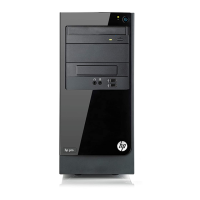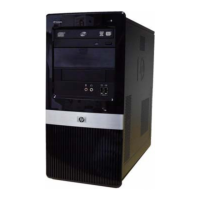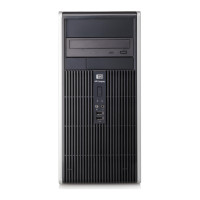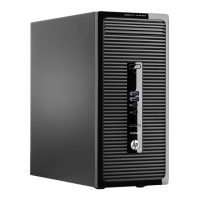Do you have a question about the HP Pro 3330 Microtower and is the answer not in the manual?
Visual identification of Microtower and Small Form Factor chassis models.
Features aiding upgrade and service, tool requirement.
Details features of Microtower and Small Form Factor chassis.
Lists and illustrates components of the Microtower chassis.
Lists and illustrates components of the Small Form Factor chassis.
Steps for software activation and customization in Windows 7.
How to download and install OS updates for Windows 7.
Procedures for installing device drivers for new hardware.
Steps for software activation and customization in Windows 8.
How to download and install OS updates for Windows 8.
Overview of functions available in the F10 Setup Utility.
Steps to access and navigate the F10 Setup Utility menu.
Details options within the 'File' menu of Computer Setup.
Details options within the 'Storage' menu of Computer Setup.
Details options within the 'Security' menu of Computer Setup.
Details options within the 'Power' menu of Computer Setup.
Details options within the 'Advanced' menu of Computer Setup.
Steps to restore system configuration settings from saved media.
Lists spare parts for the Microtower chassis.
Lists and illustrates cables for the Microtower chassis.
Lists and illustrates miscellaneous parts for the Microtower chassis.
Lists drives and their spare part numbers.
Lists miscellaneous boards and their spare part numbers.
Lists parts by sequential part number.
Lists spare parts for the Small Form Factor chassis.
Lists and illustrates cables for the SFF chassis.
Lists and illustrates miscellaneous parts for the SFF chassis.
Lists drives and their spare part numbers for SFF.
Lists miscellaneous boards and their spare part numbers for SFF.
Lists SFF parts by sequential part number.
Characteristics and specifications of SATA hard drives.
Guidelines for using and handling SATA data cables.
Explanation of SMART ATA drive technology for failure prediction.
Information on ESD and its potential damage to electronic components.
Precautions to prevent damage from ESD.
Recommended grounding methods and equipment for ESD protection.
Precautions for grounding the work area to prevent static damage.
List of recommended materials and equipment for static prevention.
Guidelines to prevent overheating and prolong computer life.
General information on computer care and cleaning.
Procedures for cleaning the computer case.
Procedures for cleaning the keyboard.
Procedures for cleaning the monitor.
Procedures for cleaning the mouse.
Considerations for computer disassembly and assembly.
Information about the power supply fan and its operation.
Lists necessary tools and software for computer servicing.
Steps to prepare the computer for disassembly.
Procedure for removing and replacing the access panel.
Procedure for removing and replacing the front bezel.
Information about system memory modules (DIMMs).
DDR3-SDRAM specifications and compatibility.
Guide to installing DIMMs for optimal performance.
Steps to remove memory modules safely.
Information about expansion cards and slots.
Procedure for removing optical drives.
Procedure for removing hard drives.
Procedure for removing the front I/O and USB assembly.
Procedure for removing the power switch/LED assembly.
Procedure for removing and replacing the system fan.
Procedure for removing and replacing the internal speaker.
Procedure for removing and replacing the fan sink assembly.
Lists processor models and their specifications.
Procedure for removing and replacing the power supply.
Procedure for removing and replacing the system board.
Information about the coin cell battery and its replacement.
Steps to prepare the SFF computer for disassembly.
Procedure for removing and replacing the SFF access panel.
Procedure for removing and replacing the SFF front bezel.
Information about SFF system memory modules.
DDR3-SDRAM specifications for SFF systems.
Instructions for installing SFF DIMMs.
Steps to remove SFF memory modules.
Information about expansion cards and slots for SFF.
Good practices for cable management in SFF PCs.
Lists drives and spare parts for SFF systems.
Guidelines for removing drives from SFF computers.
Procedure for removing optical drives from SFF computers.
Procedure for removing hard drives from SFF computers.
Procedure for removing the SFF power switch.
Procedure for removing the SFF front USB assembly.
Procedure for removing the SFF internal speaker.
Procedure for removing the SFF fan assembly.
Procedure for removing the SFF fan sink.
Lists SFF processor models and their specifications.
Procedure for removing and replacing the SFF power supply.
Procedure for removing and replacing the SFF system board.
Information about the SFF coin cell battery and its replacement.
Guidelines for safe and comfortable work environment.
Steps to isolate problems before contacting support.
General suggestions for troubleshooting computer issues.
Common causes and solutions for general computer problems.
Common causes and solutions for power-related issues.
Troubleshooting steps for hard drive errors and issues.
Solutions for media card reader issues.
Troubleshooting steps for display issues.
Troubleshooting steps for audio issues.
Troubleshooting steps for printer issues.
Troubleshooting steps for keyboard and mouse issues.
Solutions for problems encountered during hardware installation.
Troubleshooting steps for network connectivity issues.
Troubleshooting steps for memory-related issues.
Troubleshooting steps for processor issues.
Troubleshooting steps for CD-ROM and DVD drive issues.
Troubleshooting steps for USB flash drive issues.
Troubleshooting steps for front panel device issues.
Troubleshooting steps for Internet connectivity issues.
Troubleshooting steps for software-related issues.
Information on how to contact HP customer support.
Benefits of using HP PC Hardware Diagnostics tools.
Steps to access and run the hardware diagnostics.
Instructions to download diagnostic tools to a USB drive.
Procedures for restoring and recovering data in Windows 7.
Steps for system recovery when Windows is responsive.
Steps for system recovery when Windows is unresponsive.
How to perform system recovery using recovery media.
Instructions for creating recovery discs or USB drives.
Overview of backup and recovery tools in Windows 8.
How to back up personal files and system data.
Tools and methods for recovering system files.
How to use Windows recovery tools for information retrieval.
Instructions for using f11 recovery tools for hard drive image recovery.
Instructions for recovery using Windows 8 OS media.
General requirements for power cord sets applicable to all countries.
Specific requirements for power cords used in Japan.
Additional power cord requirements for specific countries.
Lists POST error codes, messages, and recommended actions.
Explanation of front panel LED and audible error codes.
Steps to disable or clear password features using a jumper.
Steps to clear CMOS settings, including AMT and passwords.
Technical specifications for the Microtower (MT) chassis.
Technical specifications for the Small Form Factor (SFF) chassis.
Visual identification of Microtower and Small Form Factor chassis models.
Features aiding upgrade and service, tool requirement.
Details features of Microtower and Small Form Factor chassis.
Lists and illustrates components of the Microtower chassis.
Lists and illustrates components of the Small Form Factor chassis.
Steps for software activation and customization in Windows 7.
How to download and install OS updates for Windows 7.
Procedures for installing device drivers for new hardware.
Steps for software activation and customization in Windows 8.
How to download and install OS updates for Windows 8.
Overview of functions available in the F10 Setup Utility.
Steps to access and navigate the F10 Setup Utility menu.
Details options within the 'File' menu of Computer Setup.
Details options within the 'Storage' menu of Computer Setup.
Details options within the 'Security' menu of Computer Setup.
Details options within the 'Power' menu of Computer Setup.
Details options within the 'Advanced' menu of Computer Setup.
Steps to restore system configuration settings from saved media.
Lists spare parts for the Microtower chassis.
Lists and illustrates cables for the Microtower chassis.
Lists and illustrates miscellaneous parts for the Microtower chassis.
Lists drives and their spare part numbers.
Lists miscellaneous boards and their spare part numbers.
Lists parts by sequential part number.
Lists spare parts for the Small Form Factor chassis.
Lists and illustrates cables for the SFF chassis.
Lists and illustrates miscellaneous parts for the SFF chassis.
Lists drives and their spare part numbers for SFF.
Lists miscellaneous boards and their spare part numbers for SFF.
Lists SFF parts by sequential part number.
Characteristics and specifications of SATA hard drives.
Guidelines for using and handling SATA data cables.
Explanation of SMART ATA drive technology for failure prediction.
Information on ESD and its potential damage to electronic components.
Precautions to prevent damage from ESD.
Recommended grounding methods and equipment for ESD protection.
Precautions for grounding the work area to prevent static damage.
List of recommended materials and equipment for static prevention.
Guidelines to prevent overheating and prolong computer life.
General information on computer care and cleaning.
Procedures for cleaning the computer case.
Procedures for cleaning the keyboard.
Procedures for cleaning the monitor.
Procedures for cleaning the mouse.
Considerations for computer disassembly and assembly.
Information about the power supply fan and its operation.
Lists necessary tools and software for computer servicing.
Steps to prepare the computer for disassembly.
Procedure for removing and replacing the access panel.
Procedure for removing and replacing the front bezel.
Information about system memory modules (DIMMs).
DDR3-SDRAM specifications and compatibility.
Guide to installing DIMMs for optimal performance.
Steps to remove memory modules safely.
Information about expansion cards and slots.
Procedure for removing optical drives.
Procedure for removing hard drives.
Procedure for removing the front I/O and USB assembly.
Procedure for removing the power switch/LED assembly.
Procedure for removing and replacing the system fan.
Procedure for removing and replacing the internal speaker.
Procedure for removing and replacing the fan sink assembly.
Lists processor models and their specifications.
Procedure for removing and replacing the power supply.
Procedure for removing and replacing the system board.
Information about the coin cell battery and its replacement.
Steps to prepare the SFF computer for disassembly.
Procedure for removing and replacing the SFF access panel.
Procedure for removing and replacing the SFF front bezel.
Information about SFF system memory modules.
DDR3-SDRAM specifications for SFF systems.
Instructions for installing SFF DIMMs.
Steps to remove SFF memory modules.
Information about expansion cards and slots for SFF.
Good practices for cable management in SFF PCs.
Lists drives and spare parts for SFF systems.
Guidelines for removing drives from SFF computers.
Procedure for removing optical drives from SFF computers.
Procedure for removing hard drives from SFF computers.
Procedure for removing the SFF power switch.
Procedure for removing the SFF front USB assembly.
Procedure for removing the SFF internal speaker.
Procedure for removing the SFF fan assembly.
Procedure for removing the SFF fan sink.
Lists SFF processor models and their specifications.
Procedure for removing and replacing the SFF power supply.
Procedure for removing and replacing the SFF system board.
Information about the SFF coin cell battery and its replacement.
Guidelines for safe and comfortable work environment.
Steps to isolate problems before contacting support.
General suggestions for troubleshooting computer issues.
Common causes and solutions for general computer problems.
Common causes and solutions for power-related issues.
Troubleshooting steps for hard drive errors and issues.
Solutions for media card reader issues.
Troubleshooting steps for display issues.
Troubleshooting steps for audio issues.
Troubleshooting steps for printer issues.
Troubleshooting steps for keyboard and mouse issues.
Solutions for problems encountered during hardware installation.
Troubleshooting steps for network connectivity issues.
Troubleshooting steps for memory-related issues.
Troubleshooting steps for processor issues.
Troubleshooting steps for CD-ROM and DVD drive issues.
Troubleshooting steps for USB flash drive issues.
Troubleshooting steps for front panel device issues.
Troubleshooting steps for Internet connectivity issues.
Troubleshooting steps for software-related issues.
Information on how to contact HP customer support.
Benefits of using HP PC Hardware Diagnostics tools.
Steps to access and run the hardware diagnostics.
Instructions to download diagnostic tools to a USB drive.
Procedures for restoring and recovering data in Windows 7.
Steps for system recovery when Windows is responsive.
Steps for system recovery when Windows is unresponsive.
How to perform system recovery using recovery media.
Instructions for creating recovery discs or USB drives.
Overview of backup and recovery tools in Windows 8.
How to back up personal files and system data.
Tools and methods for recovering system files.
How to use Windows recovery tools for information retrieval.
Instructions for using f11 recovery tools for hard drive image recovery.
Instructions for recovery using Windows 8 OS media.
General requirements for power cord sets applicable to all countries.
Specific requirements for power cords used in Japan.
Additional power cord requirements for specific countries.
Lists POST error codes, messages, and recommended actions.
Explanation of front panel LED and audible error codes.
Steps to disable or clear password features using a jumper.
Steps to clear CMOS settings, including AMT and passwords.
Technical specifications for the Microtower (MT) chassis.
Technical specifications for the Small Form Factor (SFF) chassis.
| Product type | PC |
|---|---|
| Motherboard chipset | Intel® H61 |
| Tcase | 65.3 °C |
| Bus type | DMI |
| FSB Parity | No |
| Processor cache | 3 MB |
| Processor cores | 2 |
| Processor model | i3-3220 |
| System bus rate | 5 GT/s |
| Processor family | Intel® Core™ i3 |
| Processor series | Intel Core i3-3200 Desktop Series |
| Processor socket | LGA 1155 (Socket H2) |
| Processor threads | 4 |
| Processor codename | Ivy Bridge |
| Processor frequency | 3.3 GHz |
| Processor cache type | Smart Cache |
| Processor lithography | 22 nm |
| Processor manufacturer | Intel |
| Processor front side bus | - MHz |
| PCI Express slots version | 2.0 |
| Processor operating modes | 64-bit |
| ECC supported by processor | Yes |
| PCI Express configurations | 1x16, 2x8 |
| Thermal Design Power (TDP) | 55 W |
| Number of processors installed | 1 |
| CPU multiplier (bus/core ratio) | 33 |
| Memory types supported by processor | DDR3-SDRAM |
| Memory clock speeds supported by processor | 1333, 1600 MHz |
| Memory bandwidth supported by processor (max) | 25.6 GB/s |
| Maximum internal memory supported by processor | 32 GB |
| Memory slots | 2x DIMM |
| Internal memory | 4 GB |
| Memory channels | Dual-channel |
| Memory clock speed | 1333 MHz |
| Maximum internal memory | 8 GB |
| Memory layout (slots x size) | 1 x 4 GB |
| HDD size | 3.5 \ |
| HDD speed | 7200 RPM |
| HDD interface | SATA |
| Storage media | HDD |
| Optical drive type | DVD Super Multi |
| Total storage capacity | 500 GB |
| Number of SSDs installed | 0 |
| Cooling type | - |
| On-board graphics card ID | 0x152 |
| On-board graphics card model | Intel® HD Graphics 2500 |
| On-board graphics card family | Intel® HD Graphics |
| On-board graphics card base frequency | 650 MHz |
| On-board graphics card dynamic frequency (max) | 1050 MHz |
| Number of displays supported (on-board graphics) | 3 |
| Recovery operating system | Windows 8 Pro |
| Operating system installed | Windows 7 Professional |
| Cabling technology | 10/100/1000Base-T(X) |
| Ethernet LAN data rates | 10, 100, 1000 Mbit/s |
| USB 2.0 ports quantity | 6 |
| Chassis type | Micro Tower |
| Product color | Black |
| Country of origin | China |
| Processor ARK ID | 65693 |
| Processor package size | 37.5 x 37.5 mm |
| Supported instruction sets | AVX, SSE4.1, SSE4.2 |
| Thermal solution specification | PCG 2011C |
| Intel Secure Key Technology version | 0.00 |
| Intel Identity Protection Technology version | 1.00 |
| Power supply | 300 W |
| Power supply input voltage | 100 - 240 V |
| Power supply input frequency | 50 - 60 Hz |
| Depth | 421.1 mm |
|---|---|
| Width | 173.2 mm |
| Height | 382.3 mm |
| Weight | 10000 g |











